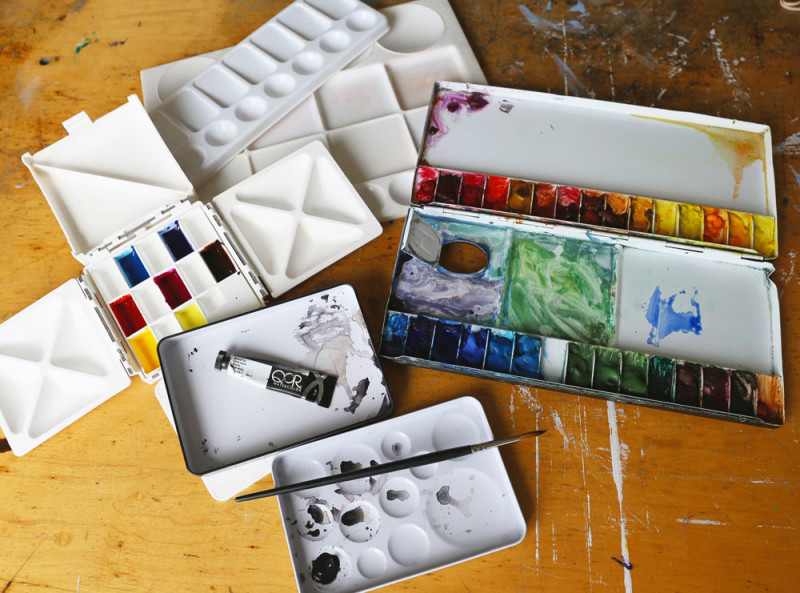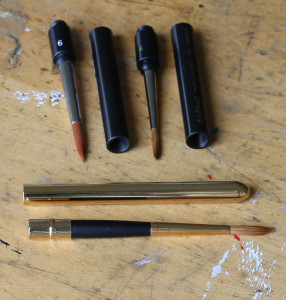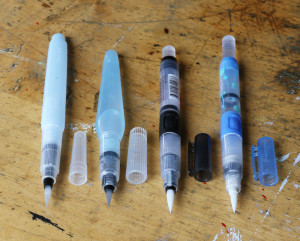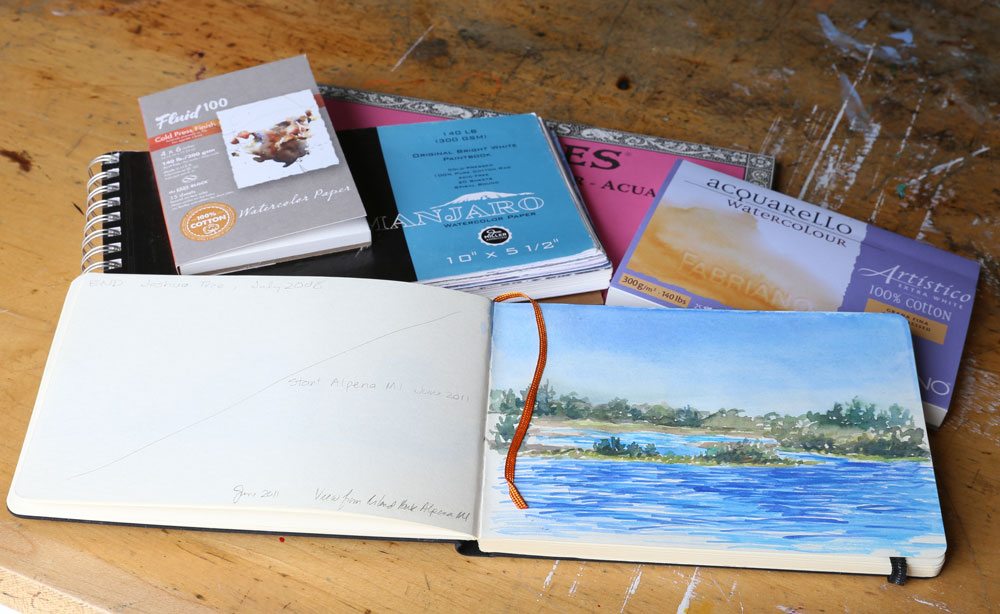When first painting with your watercolors outside, there are a few things you will definitely need, and other items that can ease your way: paint, a mixing surface or palette, water and water container, a brush, and watercolor paper on a support of some kind are the minimum things you need. Picnic tables, benches, boulders, stone fences, and the ground all provide sitting and painting areas if you travel light and do not want an easel. If you like to draw before painting, then add pens, pencils, erasers, and a sharpener to your tools. You can get by with one brush, but several will facilitate painting with varied techniques and quick color changes. Other supplies might include paper-friendly tape, paper towels or a clean rag, insect spray, sunscreen, a brimmed hat to keep the sun from your eyes, baby wipes or something similar to clean your hands, and water for you to drink while painting. It is easy to become dehydrated by sun and wind without realizing it when lost in painting. In addition, you will need something in which to carry your supplies.
Think about where you will be painting. Find a view that interests you, make sure the location will be safe, and find shade in which to work if possible. If you are in a populous area and do not like crowds watching you, position yourself in a less conspicuous place, or with your back to a wall. Do not block vehicle or foot traffic. If you feel overwhelmed by choices to paint, try zooming in on a single component, such as a doorway or a flower. This will help you become comfortable with a new location, and you can come back another time to paint a wider view, or more details as you wish.
Palettes
Palette designs are varied, from those that might hold a few half pans to those which can contain many colors. Think about what you wish to carry and what you might need. I have painted successfully en plein air with a single neutral color, and with palettes holding from three to over twenty colors. Start with a small range of paints, and expand as needed depending upon the location and the scale and intent of your painting. I usually transport the palette itself in a plastic zip lock bag to forestall wash water and damp paint making a mess in my painting kit.

Paints
A limited palette of colors allowing for a diversity of mixes might contain Cadmium Yellow Primrose (for greens), Cadmium Yellow Medium (for oranges), Transparent Pyrrole Orange (as a red-orange), Quinacridone Magenta (for purples), Ultramarine Blue (for Purples), and Manganese Blue (for greens). Adding an oxide such as Van Dyke Brown and a neutral like Payne’s Grey would provide ‘convenience’ mixes for browns and neutrals.
Brushes
For brushes, sometimes one is all that is needed. Other times, having a wide variety is good. Regular watercolor brushes are fine, although you might want to transport them taped inside a folded piece of cardboard to protect the bristles. Alternately, there are ‘travel brushes’ which have caps over the business end, or ‘water brushes’ which not only have caps, but also contain reservoirs that hold water. Try these before you go, as some of them leak. Experiment as you wish from painting trip to painting trip, and find what works best for you.



Papers
Your choices here are just as wide. There are excellent sketchbooks with watercolor-friendly papers, blocks of watercolor paper, or tear single sheets into the sizes you desire to take with you. I often have all of the above with me on a painting trip, and have found that clipboards work well to support smaller pieces of paper. When I am painting on my easel, I tack, staple, or clip larger sheets of watercolor paper to a piece of Homasote.

A Final Suggestion
I consider my painting trips as experiential processes and journeys of exploration. Whenever I paint in a new location, I find it beneficial to focus on enjoying the painting process and learning the environment, rather than on completing polished paintings. This might be a beneficial approach if painting en plein air is new to you. Focusing on the process of painting rather than the end result (the painting) may allow you to engage more freely in the experience of painting on location.
About Cathy Jennings
View all posts by Cathy Jennings -->Subscribe
Subscribe to the newsletter today!

Cathy,
Your articles and photos are so well done. I really enjoyed your article “Just Six…”, where you point out which way each primary included in the set leans warm or cool, etc. I have been a watercolor artist for years, but will admit that sometimes I have trouble making that warm/cool call within paint. Maybe something is just not tweaked right in my eyeballs! All that said, I see myself as a newborn now, with a virgin QoR 24 set to gauge against a paint cast of many. (Quite looking forward to this weekend’s studio dig-in, just to play and mix)! I hope it rains so I don’t feel guilty staying in all day!
I look forward to reading your archived articles and those to come.
Happy paint, always,
Marla
Hello Marla,
Thank you!. We are very glad you enjoy the articles and find them helpful. And we hope you had a guilt free, successful, and fun painting weekend! When I add a new paint to my palette, I often do initial mixing tests to learn about the paint’s personality. With a new red, for example, I might try mixing it with an orange-leaning yellow, to see what orange the red makes, and with a violet-leaning blue to see the purple it creates. If the new red makes a better orange than violet, the paint is ‘warm’ and biased towards yellow or orange. If the red makes a vibrant purple, it is ‘cool’ and biased to violet. I make notes of the paints used, and keep the tests for future reference. I find experiments like this can be informative. If you wish to explore your paint nerd side in a bit greater depth, “An Artist’s Color Wheel” page in the watercolor section of Bruce MacEvoy’s “Handprint” website might be helpful. This page also contains a link to an image that places pigments around a color wheel, which makes it easier to see them in relation to the primary and secondary colors. The pigments within a paint are listed on the tube, through abbreviations like “PB29” (Pigment Blue 29, or Ultramarine Blue). We hope this is helpful. And remember, we are only a telephone call away (1-800-959-6543) when you have questions!
Happy painting,
Cathy
Strange question but whatever is that folding pallet in the picture? It looks so useful!
Hello Shay,
Do you mean the white palette in the shape of a cross on the left of the photograph? If so, it is a Cloverleaf Palette.
Please let us know if you have more questions.
Warm Regards,
Cathy
Where can I find one of the plastic palettes like the one on the far left edge of your photo of palettes shown in this article? Thank you.
Hello, thank you for your question. We think you might mean the Cloverleaf palette. Their website address may be found here. If for some reason the link does not work, an internet search for “cloverleaf watercolor palette” should bring up photos and sources. The version shown in the photo does not have removable half pans, so is best for a permanent range of colors. We hope this is helpful, and we wish you happy painting! Cathy
Just painted plein air for the first time this weekend. The days are long, and I was taking a professional class near many beautiful places. I like the pigments you suggest, as there were very bright greens in the landscape I didn’t capture with an azo yellow, even though I did have a genuine manganese blue in the palette. The one thing I’d add to the supply list is clips to hold the sketchbook open although you did mention these in passing. The thing I forgot was a brimmed hat, but other than that my painting kit is very functional and I look forward to more painting!